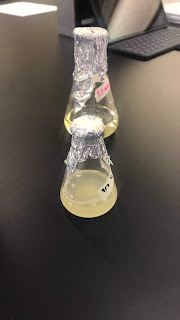Algae and Vibrio Fisheri

Hi! I hope everyone had a great summer! Currently, I am working on the disruption of bacterial Quorum Sensing. Quorum Sensing is how bacteria's communicate. In Vibrio Fisheri (V. Fisheri ) it controls a behavior such as bioluminescence. Also, I just started working with C. Reinhardtii (algae). Algae produce compounds that mimic N-acy homoserine lactone (AHL). V. Fisheri is grown in a PB agar plate and algae was grown in a liquid TAP . I still haven't gone to this step, but the next step will be to add algae to the center of each plate. This will cause the center of the plate to stop growing. It's the AHL blocking the QS signals who controls the bioluminescence.


